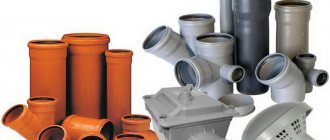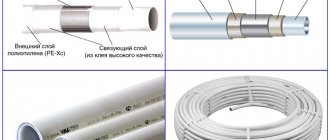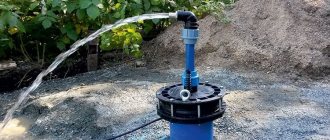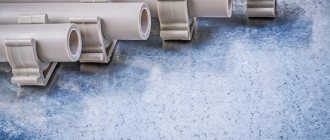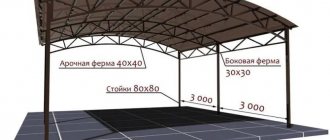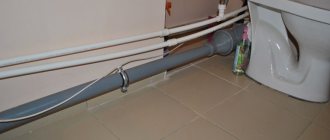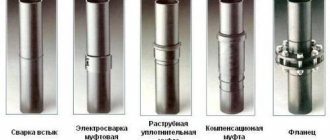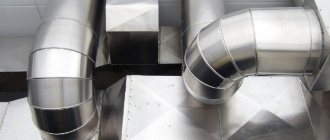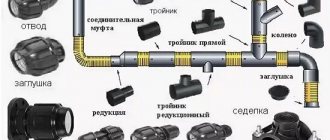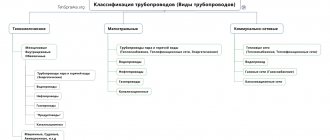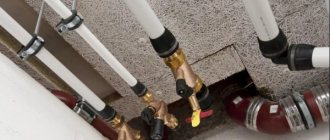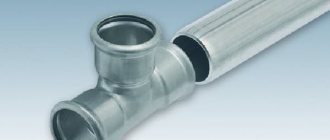Just forty to fifty years ago, fiberglass pipes were not familiar to humanity. But already at the end of the seventies of the last century, Western scientists managed to solve the problem of corrosion of metal pipes through the use of new materials. Then fiberglass pipes began to be actively used.
A fiberglass pipe is made of a composite material – fiberglass. Depending on the type of resin, the amount and types of reinforcing materials used, as well as production technology, the mechanical and physical properties of the product may change.
Application area
A popular manufacturer of fiberglass pipes, Amiantit, produced a trial batch of pipes in the late sixties of the last century. Over the decades, the manufacturer has managed to reach the global level and now fiberglass reinforced plastic (GRP) pipes deserve attention due to their quality and reliability. This is due to the fact that the pipes are made using a special method - continuous spiral winding. As a result, they are not subject to corrosion and become very resistant to acids and environments. In addition, unlike standard metal pipes, fiberglass pipes are easy to handle - the weight of the products is many times less than heavy metal ones. Therefore, if there are any doubts about whether to buy fiberglass or traditional metal pipes, most companies choose durable and practical materials for laying fiberglass pipes.
In just forty to fifty years, the leading company of the same name for the production of fiberglass pipes managed to take not only a leading position, but also become a step higher.
The scope of application of fiberglass pipes is quite wide; they can be used for laying sewerage and drainage systems, as well as for fire fighting, transporting drinking and industrial water. Pipes can be laid at power plants and for the removal of any type of waste.
In addition, fiberglass pipes are widely used for laying almost any type of communications:
- trunk lines;
- sewer networks for any purpose;
- water supply;
- laying gas and oil pipelines.
Popular Amiantit factories take into account the interests of each consumer when producing their products - you can purchase fiberglass pipes of different diameters, lengths and designs, as well as additional components and fittings. In addition, the production process is adjusted in such a way as to satisfy the requirements of any buyer and produce customized pipes.
The diameter of a standard fiberglass pipe ranges from one hundred to three thousand seven hundred millimeters, and the length can reach eighteen meters. The use of such pipes is permitted in six pressure classes and three strength classes. Thanks to these indicators, we can confidently say that fiberglass pipes are not only efficient. The high durability of the products is also noted.
Standards
The production of the products we are interested in is regulated by two regulatory documents:
- GOST R 53201-2008 contains technical conditions for the manufacture of pipes with a diameter of 50-200 mm with threaded connections.
- Developed with the participation of NTT LLC (New Pipe Technologies), GOST R 54560-2011 describes parts of pipelines made of “fiberglass-reinforced thermosets”.
Let's study the main provisions of the documents.
GOST R 53201-2008
The pipe operation mode specified by the standard looks like this:
- Temperature – from -60 to +60С.
- Relative humidity – up to 100%.
- The temperature of the transported liquid is up to +110C.
- Working pressure – from 3.5 to 27.6 MPa.
The following options for using the products described by the standard are provided:
- Transportation of oil and gas condensate.
- Transportation of salt solutions (including sea water).
- Construction of elevator columns.
- Fastening wells for various purposes.
Disassembled casing.
- Maintaining reservoir pressure during the development of underground fields.
- Technical and drinking water supply.
The standard distinguishes three types of pipes:
| Designation | Decoding |
| NK | Pump and compressor |
| ABOUT | Casing |
| L | Linear |
What are the diameters of fiberglass pipes produced in accordance with GOST R 53201-2008, and their other characteristics?
Pumping and compressor, casing
| Inner diameter, mm | Nominal pressure, MPa | Minimum wall thickness, mm | Weight per linear meter, kg |
| 50 | 6,9 – 27,6 | 4,3 – 8,4 | 1,6 – 3,3 |
| 63 | 6,9 – 27,6 | 4,6 – 10,7 | 2,2 – 5,5 |
| 100 | 10,3 – 17,2 | 8,1 – 12,2 | 5,8 – 8,2 |
| 150 | 10,3 – 17,2 | 13,5 – 15,0 | 14,0 – 14,9 |
| 200 | 10,3 | 13,6 | 16,5 |
The photo shows high-pressure fiberglass tubing.
Linear
| Inner diameter, mm | Nominal pressure, MPa | Minimum wall thickness, mm | Weight per linear meter, kg |
| 50 | 10,3 – 27,6 | 2,79 – 8,10 | 1,2 – 3,1 |
| 63 | 8,6 – 27,6 | 2,80 – 9,90 | 1,4 – 5,2 |
| 100 | 5,5 – 27,6 | 2,80 – 16,00 | 2,3 – 12,8 |
| 150 | 5,5 – 13,8 | 4,57 – 11,20 | 5,1 – 12,2 |
| 200 | 5,5 – 13,8 | 5,84 – 14,70 | 8,6 – 22,6 |
In addition to the standard sizes of pipes, the document contains detailed instructions for the manufacture of fittings, indicating the basic dimensions, requirements for appearance, maximum tolerances and marking of all products.
GOST R 54560-2011
The standard describes pipelines operating under much milder conditions than those described above:
- Working pressure – up to 3.2 MPa;
- Ambient temperature – up to 35C;
- Transported liquids – water, aqueous solutions and wastewater (domestic and industrial).
Soft requirements for strength make it possible to get by with walls of low thickness.
Important: GOST does not apply to pipelines for internal water supply and sewerage systems.
Within the framework of the document, products are classified according to the following criteria:
- Diameter (DN). The range of values is from 300 to 3000 millimeters.
- Nominal pressure (PN). For non-pressure pipes, the concept of PN itself is quite arbitrary and is taken equal to 0.1 - 0.4 MPa; for pressure ones it takes values of 0.6, 1.0, 1.6, 2.0, 2.5 and 3.2 MPa.
- Nominal hardness (SN). It is also measured in megapascals and can be equal to 1250, 2500, 5000 and 10000.
Please note: when laying a fiberglass sewer system with your own hands, it is worth considering that SN 1250 pipes are not recommended for underground installation in principle, and SN 2500 pipes are recommended for laying in trays.
For underground installation, thick-walled, high-rigidity pipes are used.
The document, like the previous one, lists the main dimensions of all types of fittings and the requirements for their appearance, strength, marking and reinforcement methods.
Main advantages
Most pipes are made according to a standard pattern - fiberglass threads are wound onto a durable frame in a continuous manner. The thread is reinforced with a special fiberglass compound and impregnated with a resin mixture, crushed fiberglass and sand. Thanks to this technology, pipes can last more than fifty years. It is not yet possible to talk about a longer service life, because only half a century has passed since the release of the first batch of products. But, according to experts, such pipes can last much longer.
What are the advantages of fiberglass pipes:
- long service life;
- easy installation. It is very easy to connect pipes using an additional coupling connection. There is no need to use welding and control the quality of the connecting seam, which allows you to significantly save time and money during installation;
- ease. If we compare the weight of a standard-sized pipe with a similar pipe, but consisting of a high-quality steel alloy, then a fiberglass pipe will be eighty percent lighter;
- does not rust and there is no need to perform additional actions to combat corrosion;
- the material is resistant to wear and is not exposed to aggressive components;
- installation can be performed both in winter and summer - temperature changes do not have a significant effect on installation;
- the price of a fiberglass pipe does not depend on the cost of metal and energy;
- meet environmental standards;
- fiberglass can withstand temperature fluctuations - from minus sixty-five to plus one hundred and fifty-five degrees Celsius.
When choosing fiberglass pipes, the following must be considered:
- Fiberglass pipes must not contain foreign particles.
- The surface must be flat and smooth.
- Pay attention to the edge of the pipe - it should be smooth and even, without cracks or delaminations.
- Pipes can be sawed, drilled, sharpened and milled, and the surface of a high-quality product under mechanical stress is not subject to delamination, chipping or cracking.
The service life of a fiberglass pipeline is eight times longer (when compared with a pipeline made of an alloy of metals), so you don’t have to worry about corrosion and other coating protection methods.
Right choice
To select the correct pipe design, it must be carefully inspected to identify damage or poor-quality parts.
- It should be smooth, without swelling, and the material should not contain various types of inclusions.
- It is also worth paying attention to its edge; it should be smooth and even. If there are delaminations or cracks at the edge, then such a pipe cannot be used. This is considered a manufacturing defect and will not last long.
- If a fiberglass pipe requires cutting and sawing, then no cracks or chips should form on its edge and the material should not delaminate. If this happened, then most likely the design was made of low-quality materials or the production was carried out using the wrong technology. This design can become damaged very quickly.
Kinds
To increase the strength of products, manufacturers have developed several types of fiberglass pipes that can be used in various fields of activity. So, in order to achieve strength in the connections of fiberglass pipes, different types of shear reinforcement have been developed. In addition, the shear strength of the groove wedge can be increased by strengthening the side edge of the wedges. Thanks to this technology, such pipes can be used for rotary wedges.
According to the cross section, fiberglass pipes are divided into the following types:
- Solid section. Its shape can be different - in the form of a rectangle, circle, trapezoid, semicircle and segment.
- “Ring” section. Pipes with this cross-section are manufactured only to order, all details being discussed in advance with the customer.
Different types of resins can be used in the production of fiberglass pipes. To enhance the strength of the product, orthophthalic, isophthalic and bisphenolic resins are added during the production of products, thereby increasing resistance to alkaline solutions, salts and acids.
Each type of pipe can be divided into two types: single-layer pipe and multi-layer pipe. The first consists of a composite material and is manufactured using wet winding technology. The composition of the pipe is dominated by epoxy resin and the binding material – glass fibers. Multilayer pipes are “clad” in an additional shell (one or more) made of durable polyethylene. Each layer is bonded to the previous one due to polymerization at high temperatures, which increases the resistance of the pipe to various influences.
What are they?
Fiberglass is a multicomponent material consisting of fiberglass filler and a polymer binder. This combination in the composite leads to the appearance of qualitatively new mechanical properties. Strong glass or plastic fiber is used as a filler in fiberglass; epoxy and polyester resins are most often used as a thermoset binder.
The technological ability to produce fiberglass pipes appeared in the 50s of the twentieth century. But the low price of traditional metal pipes (even copper and stainless steel) prevented the spread of fiberglass products.
In the 60s, the quality of fiberglass improved, and it became possible to use them at high pressures. Simultaneously with the emerging demand for durable, corrosion-resistant materials in the oil and coal industries, metal prices began to rise.
With the increase in technical characteristics, fiberglass plastics have become widespread, especially in North America and Saudi Arabia. In the 80s, fiberglass pipelines began to appear in all countries with developed industry.
What are the disadvantages of fiberglass pipes?
Along with the advantages, fiberglass pipes also have a number of disadvantages. Thus, during the operation of fiberglass pipes, the following features were identified: with a significant load across the fibers of the product, low resistance to cracks was noted, which does not allow the pipes to be used when laying oil pipelines. This can be avoided by strengthening the sealing of the pipes from the inside using a special corrugated sealing layer.
Installation of fiberglass pipes
Installation of fiberglass pipes can be done in different ways.
Let's consider the most accessible and effective:
- The standard socket type pipe can be easily installed. The installation technology does not differ from the installation of polyvinyl chloride sewer pipes. When installing, you should follow a certain sequence - insert one pipe into the extension (socket) of the next one.
- Connecting pipes using the flange method. Each pipe at the end is equipped with a special flange (ring) with holes for fasteners.
- Coupling connections - used for pipes of all types. It is possible to additionally install removable connections or structures without subsequent disassembly (use of adhesive materials).
- “Yoke” type connection, a type of coupling installation. This is a special device with which you can easily join pipes and then connect them with fasteners (for example, bolts).
- In some cases, it is possible to use screw and threaded connections for plastic pipes.
Manufacturing methods
Fiberglass pipes are made on the basis of four technologies, which are radically different from each other. To obtain composite products use:
1. Winding (winding). It is expected to be quite high in performance and extremely simple to implement. There are different types of winding:
- simple;
- continuous.
Winding is divided according to the use of polymer binders:
- thermosetting – polyester, phenol-formaldehyde, epoxy and other resins;
- thermoplastic - polyamide, polypropylene, polyethylene, polyethylene rephthalate, etc. In this case, one- or two-stage technology is possible.
Reinforcing glass fiber is laid in different ways, but large-scale industrial production is carried out only in four ways:
- spiral-ring. This is how high-pressure and structural fiberglass pipes are made for solid-fuel rocket engine housings and power line supports. Large-diameter fiberglass pipes are practically not produced using this method due to the high complexity and high cost of the process ;
For the manufacture of pipes, different methods of winding and winding the material are used.
- spiral-ribbon. Simplification of the technological process makes it possible to produce large-diameter products. But it results in a decrease in quality; fiberglass pipes for pipelines with medium or low pressure are produced in this way;
- longitudinal-transverse. With this method, the fibers are laid independently of each other by the machine;
- oblique longitudinal-transverse. The method was developed at the Kharkov Aviation Institute to mass produce fiberglass casings for rockets.
Important! The latter method differs from others in obtaining the highest glass content in the resulting product. It reaches 85% of the total mass of fiberglass. Close to this method is the rarely used fiberglass winding, which is used to produce small batches of large-sized products.
2. Centrifugal molding (casting). This method, which allows an almost unlimited increase in wall thickness, produces pipes with increased ring rigidity, as well as products for microtunneling that are subject to high axial loads.
3. By pultrusion (broaching) method. High-performance equipment produces small-diameter pipes and fishing rods for heating systems and plumbing.
4. By extrusion (squeezing) method. Simplification of technology to increase productivity to the highest level makes it possible to produce from thermoplastics, mainly, products with non-continuous reinforcement, i.e., with deteriorated physical and mechanical characteristics.
In addition to production technology, pipes differ in material composition, which affects their properties.
Marking
Depending on the coating and purpose, each pipe has a specific marking. It is not difficult to understand these notations. Products intended for laying water pipelines, supplying drinking and domestic water are designated by the letter “P”. The marking indicates that fiberglass pipes can be used for any water supply, including drinking water supply.
Letter “G” - pipes are allowed to be used in hot water supply systems, provided that the temperature of the water or other energy carrier does not exceed seventy-five degrees.
“X” - the designation of this letter indicates that pipes can be laid for transporting gases and other chemically active substances.
If the liquid contains abrasive inclusions, then such substances can be pumped through pipes marked “A”.
Universal fiberglass pipes are marked “C”; in addition, the products are resistant to acid.
